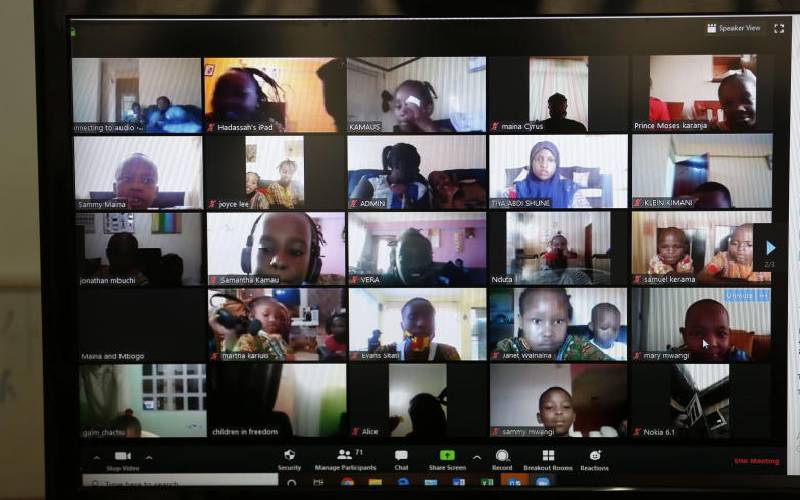
Thanks to Covid-19, online learning skeptics are holding their heads in disbelief. The ground just shifted beneath their feet. Look, the traditional classroom learning is fast fading, giving rise to a rather impersonal method of teaching and learning.
The teacher – student relationship is considerably artificial in the new virtual environment, yet this, we are told, is the new norm. Moreover, the power-relation between the learner and the instructor must be redefined as we probably eliminate the teacher-controlled class.
Let us begin with the basic social transformation in the education sector following the closure of learning institutions as a containment measure against the coronavirus spread. University education in Kenya, like in many other countries, is going online. Not that we did not have online distance learning before, but that the uptake has been intense since Covid-19 found its way into Kenya.
Universities have developed policies and protocols on how to utilise modern information and communication technologies as an alternative to classroom learning. Even examinations are now conducted online in spite of many teething problems.
Organisations working in emergency situations, well known for their humanitarian interventions, know that most emergencies are transitory. But they can mutate into a long term humanitarian crisis requiring specialised support as we see in refugee camps.
Will the pandemic curve flatten this year, early next year or end of 2022? With examples of a resurgence of the virus spread, at this point, we do not have any guarantees on when to expect a return to normalcy. WHO says only vaccination will offer us immunity against the virus. However, this position in itself is contestable.
The emergency period, if it turns out to be the “new norm”, has provided us with significant lessons for teaching online. First, a leap in technology adoption means a change in teaching methodologies. Keeping the learners in the virtual class for three hours calls for creativity of a kind, since the learners are fully in charge of the learning space they are in for the session.
The instructor can hope the student follows the lessons and engages in discussions and other class activities. With now most information digitised and at the click of a button, teachers must be organisers of knowledge, and the reality of virtual learning might, or should provide curricular planners ideas to innovate. Second, the student-lecturer interaction in classroom, in the corridors, in the university café and especially in supervision of projects will evolve into “talking heads” sessions. There is too much mechanisation of human relations in online learning.
Third, mentorship programmes, formal and informal, will die a natural death. Some form of mentorship online and offline will emerge, but the more human-touch trust-building space will be no more. Fourth, the academic aura that forms a critical part of staff socialisation may henceforth be reduced to “jambo sana” sessions.
The real opportunities in this virtual learning space rest on time saving (no more battling traffic), ease of ‘getting to class’, the comfort of your chair , providing learning material in an easy to access platform and of course avoiding the usage of smartboards, PowerPoints or other gadgets that sometimes are hardly maintained.
On the one hand, the “new norm” may turn out to be hot air. Of course, natural science labs will not be transferred to virtual spaces, much as artificial intelligence now bridges aspects of lab experimentations. Students learning cervical spondylosis will get as much online as in labs, except for human experimentation. Nevertheless, the need for lab presence will continue to be the norm.
Even those in the humanities and social sciences might find it untenable to run undergrad programmes online. On the other hand, postgraduate programmes will be a real test. Some of the students just want the knowledge, not academic ambiance. Most postgraduates are work-study students. This group does not really benefit from the privileges of being physically in class.
Assuming we are not turning back to the old norm, what do we do with all the physical buildings and supporting infrastructure in every university? Take the libraries for example. Why do we need a physical space to store books and journals that are easily available online? Wouldn’t one library just serve the whole university student population in Kenya? A number of those Commission of University Education requirements will be checked off.
Dr Mokua teaches media and communication studies.
Stay informed. Subscribe to our newsletter
 The Standard Group Plc is a
multi-media organization with investments in media platforms spanning newspaper
print operations, television, radio broadcasting, digital and online services. The
Standard Group is recognized as a leading multi-media house in Kenya with a key
influence in matters of national and international interest.
The Standard Group Plc is a
multi-media organization with investments in media platforms spanning newspaper
print operations, television, radio broadcasting, digital and online services. The
Standard Group is recognized as a leading multi-media house in Kenya with a key
influence in matters of national and international interest.
 The Standard Group Plc is a
multi-media organization with investments in media platforms spanning newspaper
print operations, television, radio broadcasting, digital and online services. The
Standard Group is recognized as a leading multi-media house in Kenya with a key
influence in matters of national and international interest.
The Standard Group Plc is a
multi-media organization with investments in media platforms spanning newspaper
print operations, television, radio broadcasting, digital and online services. The
Standard Group is recognized as a leading multi-media house in Kenya with a key
influence in matters of national and international interest.










